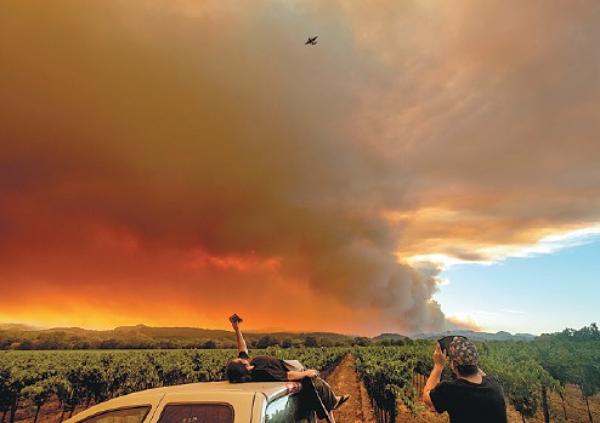 In this Feb 2, 2018 photo, chinstrap penguins walk by a scientific station on Fildes peninsula, King George Island, Antarctica. (MATHILDE BELLENGER / AFP)
In this Feb 2, 2018 photo, chinstrap penguins walk by a scientific station on Fildes peninsula, King George Island, Antarctica. (MATHILDE BELLENGER / AFP)
Dire natural disasters have not gone away with many even making history while the COVID-19 pandemic wreaked havoc across the world in 2020.
The pandemic has not only complicated evacuations and disaster response, but also aggravates the economic impact of disasters, especially for the poorest people.
Maarten van Aalst, director of the International Federation of Red Cross and Red Crescent Societies
Bushfires across Australia burned from late 2019 into early 2020, ravaging more than 115,000 square kilometers of drought-stricken bushland and forest. More than 30 people were killed and thousands of homes were destroyed.
Wild animals bore the brunt of the broadest and most prolonged bushfire season in modern Australian history. Nearly 3 billion animals, including 60,000 koalas, were killed, hurt, or displaced.
Record-breaking rains and floods in China swept large areas of its southeastern region, affecting more than 63 million people and inflicting a direct economic loss of 178 billion yuan (US$27 billion) as of mid-August. The floods left more than 200 people dead or missing, with 54,000 houses destroyed.
ALSO READ: China, US militaries discuss humanitarian aid, disaster relief
Devastating wildfires are striking more often in the United States.
Data from the National Interagency Fire Center showed that 57,850 wildfires incinerated more than 4.1 million hectares across the US as of Dec 23.
Wildfires in California, the hardest-hit state, torched a record 1.74 million hectares, damaging or destroying more than 10,500 structures and killing at least 30 people.
Though they are called natural disasters, the toll they take comes in part from human activity.
Zhou Weidong, director of the World Business Council for Sustainable Development's office in Beijing, said extreme weather events are the visible consequences of an increasingly warming world, fueled by greenhouse gas emissions.
It is affecting the planet's life-sustaining systems, from the top of the mountains to the depths of the oceans, affecting ecosystems and human security, he said.
Climate change, apparently, has not stopped for COVID-19.
Emissions are heading in the direction of pre-pandemic levels following a temporary decline caused by widespread lockdowns. Greenhouse gas concentrations in the atmosphere are at record levels.
From 2016-20, the world experienced its warmest five years on record in a trend which is likely to continue. The world is not on track to meet agreed targets to keep temperature increases below 2 C or at 1.5 C above preindustrial levels, according to the United in Science 2020 report, compiled by the World Meteorological Organization, or WMO.
"This report shows that whilst many aspects of our lives have been disrupted in 2020, climate change has continued unabated," said WMO Secretary-General Petteri Taalas.
Even Antarctica, the most remote place on the planet, has not escaped global warming. Fossil fuel burning thousands of kilometers away is heating up the region faster than almost anywhere else.
 An ominous glow emanating from a massive cloud of smoke makes evident the destruction caused by a distant wildfire in Healdsburg, California, on Aug 20. Deadly wildfires in California in 2020 more than doubled the previous record for the most land burned in a single year in the state. (NOAH BERGER / AP)
An ominous glow emanating from a massive cloud of smoke makes evident the destruction caused by a distant wildfire in Healdsburg, California, on Aug 20. Deadly wildfires in California in 2020 more than doubled the previous record for the most land burned in a single year in the state. (NOAH BERGER / AP)
Take-home message
A study published in June in the Nature Climate Change journal showed the South Pole warmed at a rate of 0.61 C per decade over the past three decades, "an incredible three times faster than the global average rate".
"The real take-home message from the study is that no place is immune to climate change," wrote scientists Sharon Stammerjohn and Ted Scambos of the University of Colorado in an accompanying article in the journal.
"Unless we take measures to flatten the curve on global carbon emissions, Antarctica's contribution to a warmer world and sea-level rise could potentially be catastrophic, given the strong feedbacks and tipping points inherent in polar systems."
At the same time, the pandemic has also made things worse. It has aggravated the impact of climate-related disasters in poor regions, affecting tens of millions of vulnerable people already hit hard by COVID-19.
"The pandemic has not only complicated evacuations and disaster response, but also aggravates the economic impact of disasters, especially for the poorest people," Maarten van Aalst, director of the International Federation of Red Cross and Red Crescent Societies, was quoted by news agency Reuters as saying.
READ MORE: Decades of effort help control floods and pollution in Huaihe
On the bright side though, the pandemic has heightened environmental awareness.
A survey released in July by Boston Consulting Group found that people were more concerned now than before COVID-19 about addressing environmental challenges and more committed to changing their own behavior to advance sustainability.
More than two-thirds of respondents think economic recovery plans should make environmental issues a priority.
"Coronavirus is a reminder of our dysfunctional relationship with nature. People are now more respectful to the way that nature works," Zhou said.


